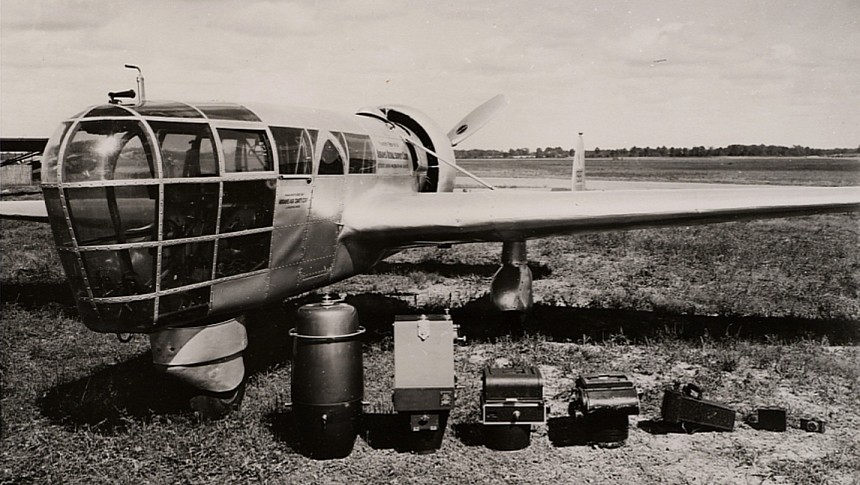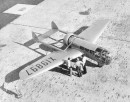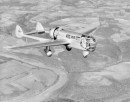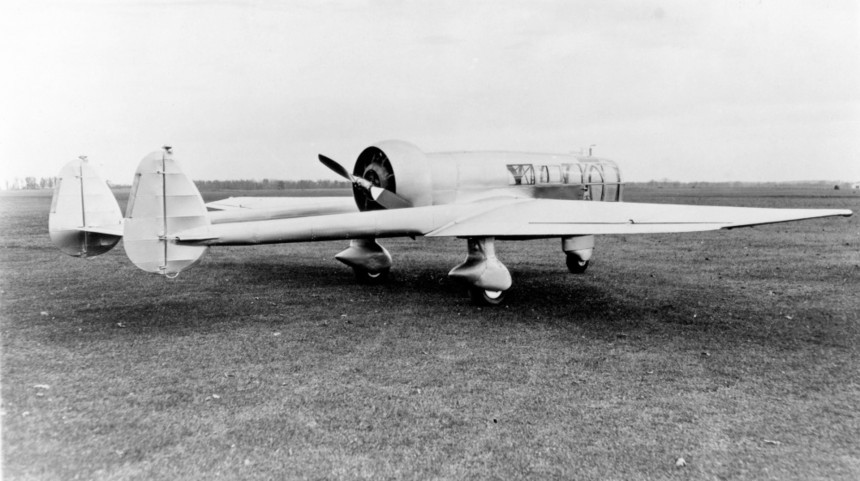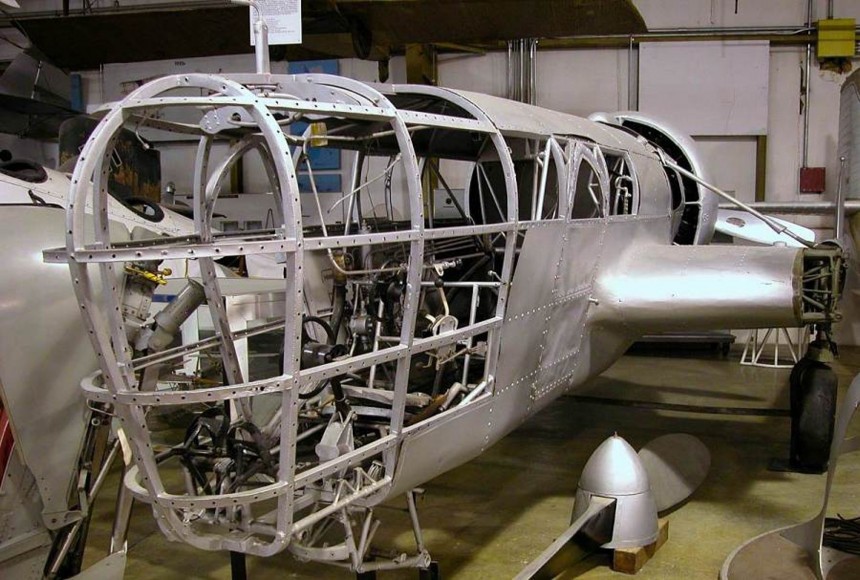Every airplane, no matter how useful or useless, always has a purpose. Some fly hoards of sweaty, irritated passengers from tourist trap to tourist trap while supplying a steady supply of little bottles of alcohol for their troubles. Others drop massive stockpiles of military ordinance across vast swaths of enemy territory, praying to high holy heaven they don't hit civilians. But some planes are built for a more eclectic and special calling, one that's neither commercial nor military. This is the Abrams P-1 Explorer, perhaps the first aircraft ever built exclusively for aerial photography.
The story behind the Abrams Explorer is one of stunning innovation, at a time when every aerospace engineer worth their salt was working for the military. But in the buildup to the biggest war the world has ever seen, a man called Talbert Abrams had his sights set on something else entirely. Born on August 17th, 1895, in Tekonsha, Michigan. Abrams was a man born in the era of aviation's first real pioneers. A time when people like the Wright Brothers and Glenn Curtiss did everything in their power to one-up each other.
So the story explains Abram's zest for powered flight dates back to his father enthusiastically telling the tale of the Wright Brother's first successful flight after reading about it through the local newspaper at just eight years old. In his young adulthood, Abrams secured a job with the Curtiss Aeroplane and Motor Company factory in Buffalo, New York as a humble machinist's assistant. It was at one of Glenn Curtiss' aviation schools in San Diego, California, where Abrams first earned his Fédération Aéronautique Internationale (FAI) pilot's license. Ironically, this license was signed off on by one of Curtiss' arch-rivals, the FAI's committee chairman Orville Wright.
It was when Talbot Abrams, who was most often called by his nickname "Ted," joined the U.S. Marine Aviation Section that he learned he not only loved building airplanes but flying in them as well. Though he entered service too late to join World War I, Abrams would soon cut his teeth in military aviation, flying missions above the Caribbean. While there, Abrams was tasked with taking aerial photographs over Haiti, then besieged by a rebellion against the U.S. forces then occupying the island, from the back seat of a biplane. It was these missions that gave Ted Abrams his lifelong passion. But during these missions, Abrams found it exceedingly difficult to conduct his photography with the precision and clarity which he strived for in his work. Shakey, leaky World War I biplanes were a handful to fly aboard, even for the pilots. With this in mind, it makes sense why Abrams had all the hell he could handle trying to make his aerial photographs presentable.
While other aspiring engineers strived to make aircraft faster, sleeker, and better at shooting down other airplanes, Ted Abrams yearned to build airplanes that were better at taking photographs. This process wouldn't happen overnight, far from it, in fact. After getting out of the U.S. Military, Abrams spent time offering chartered passenger flights aboard a surplus Curtiss JN-4 Jenny biplane to fund his endeavors in aerial photography. In 1923, Abrams heavily modified a Standard J-1 military training biplane with some of the highest-quality camera equipment available in the early 1920s. Still not all that impressive by modern standards. But by the standards of the era, Abrams' J-1 was like the U-2 spy plane of the day.
The plane would become the first product of the eponymously founded Abrams Aerial Survey Corporation. Abrams even founded a second venture, the Abrams Instrument Corporation, and dedicated it to developing aerial-photography equipment to his exact specifications. But it wouldn't be until 1937 that Abrams hired two prominent Michigan engineers, Andrew Edward Kunzl and Kenneth Ronan, to design his own bespoke airframe designed solely for aerial photography; it was named the P-1 Explorer. What Abrams desired most of all from his first airplane was an interior free of the obstacles and restrictions that made his job with the Marine Aviators such a chore.
Only when the aircraft's observation deck was clear of conditions that adversely affect a camera's exposure, aperture, or general clarity did Abrams deem the design appropriate for production. The P-1 Explorer's rear-mounted, pusher-style engine and prominent plexiglass nose portion took on this arrangement to compensate for these concerns. Ironically, Abrams employed the German Rohm and Haas group to manufacture the Explorer's plexiglass nose section, as a trade embargo between Nazi Germany and the U.S. had yet to be placed by 1937. The rest of the P-1's mono-wing airframe was manufactured out of lightweight aluminum alloy with a clever tricycle-style landing gear arrangement.
With dimensions of 26 feet, six inches (8.08 m) long and a 36-foot, eight-inch (11.18 m) wingspan, the P-1 was roughly on par in size with contemporary single-engine fighters like the Curtiss P-36 Hawk or the Seversky P-35. But with just a 330-horsepower Wright Whirlwind nine-cylinder radial engine to work with, it's clear that the slow, meticulous approach was much more up the P-1's alley. Indeed, a 200 mph top speed might sound pathetic. But when you're aiming for the cleanest exposure possible on an air-to-ground photograph, you simply don't need to fly any faster.
Typically, the P-1 Explorer spent most of its time in the air not even touching its top speed. Opting instead to loiter over a mapping zone where its thick delta wing let the two-person crew hover over the zone, which needed mapping. From there, any number of different types of camera or mapping equipment could be mounted inside the P-1 Explorer's hermetically-sealed payload bay. But more often than not, an Abrams Instrument Corporation C-3 camera could capture around 650 nine-by-nine-inch photographs from a single reel of film.
Sometime after the P-1 Explorer's first flight in November 1937, the aircraft was sent back to its designers, where its engine underwent further tuning to up its power from 330 hp to 450 in hopes of attracting a buyer. But sadly, the Second World War necessitated that the slow, unarmed P-1 Explorer be put into storage to wait out the conflict. All the while, modified variants of legit military planes like Spitfires, P-51 Mustangs, and P-38 Lightnings became the first generation of legitimately practical military aerial-reconnaissance planes. By the time the war ended in 1945, the P-1 Explorer was all but obsolete.
Now more useful as a museum piece than a functioning photography plane, the P-1 Explorer was donated to the Smithsonian National Air and Space Museum in 1948. There, the plane sat in storage for 25-plus years. Until a team of engineers and amateur aviation enthusiasts from places like General Motors, the Michigan Aerospace Educational Association, and even ex-employees of Abrams Aerial Survey itself petitioned the Smithsonian to ship the P-1 Explorer to Michigan for restoration. First assembled in 1968, it'd take until January 1975 for the Smithsonian to approve the proposal.
From there, the P-1 was transported to Lansing, Michigan, via a Michigan Air National Guard C-130 transport plane to the city's Capital Region International Airport. At this point, a slow and meticulous disassembly was undertaken before the wings were disassembled and transported to the nearby Montcalm Community College for a complete cosmetic restoration. Meanwhile, the engine and fuselage were transported to a facility in the aviation program at the nearby Lansing Community College. Unfortunately, the restoration was never completed.
By 1981, all of the P-1's components were taken back to the Paul E. Garber Preservation, Restoration, and Storage Facility in Suitland, Maryland, where it's remained unrestored for the last 42 years. If you ask any of us, that's a real tragedy. Not just because of how important the P-1 was to the history of aviation but even photography in general. If there were ever a candidate worthy of being of some TLC from the Smithsonian's Restoration Hangar at the Stephen Udvar-Hazy Center, it's got to be the brainchild of Ted Abrams.
So the story explains Abram's zest for powered flight dates back to his father enthusiastically telling the tale of the Wright Brother's first successful flight after reading about it through the local newspaper at just eight years old. In his young adulthood, Abrams secured a job with the Curtiss Aeroplane and Motor Company factory in Buffalo, New York as a humble machinist's assistant. It was at one of Glenn Curtiss' aviation schools in San Diego, California, where Abrams first earned his Fédération Aéronautique Internationale (FAI) pilot's license. Ironically, this license was signed off on by one of Curtiss' arch-rivals, the FAI's committee chairman Orville Wright.
It was when Talbot Abrams, who was most often called by his nickname "Ted," joined the U.S. Marine Aviation Section that he learned he not only loved building airplanes but flying in them as well. Though he entered service too late to join World War I, Abrams would soon cut his teeth in military aviation, flying missions above the Caribbean. While there, Abrams was tasked with taking aerial photographs over Haiti, then besieged by a rebellion against the U.S. forces then occupying the island, from the back seat of a biplane. It was these missions that gave Ted Abrams his lifelong passion. But during these missions, Abrams found it exceedingly difficult to conduct his photography with the precision and clarity which he strived for in his work. Shakey, leaky World War I biplanes were a handful to fly aboard, even for the pilots. With this in mind, it makes sense why Abrams had all the hell he could handle trying to make his aerial photographs presentable.
While other aspiring engineers strived to make aircraft faster, sleeker, and better at shooting down other airplanes, Ted Abrams yearned to build airplanes that were better at taking photographs. This process wouldn't happen overnight, far from it, in fact. After getting out of the U.S. Military, Abrams spent time offering chartered passenger flights aboard a surplus Curtiss JN-4 Jenny biplane to fund his endeavors in aerial photography. In 1923, Abrams heavily modified a Standard J-1 military training biplane with some of the highest-quality camera equipment available in the early 1920s. Still not all that impressive by modern standards. But by the standards of the era, Abrams' J-1 was like the U-2 spy plane of the day.
Only when the aircraft's observation deck was clear of conditions that adversely affect a camera's exposure, aperture, or general clarity did Abrams deem the design appropriate for production. The P-1 Explorer's rear-mounted, pusher-style engine and prominent plexiglass nose portion took on this arrangement to compensate for these concerns. Ironically, Abrams employed the German Rohm and Haas group to manufacture the Explorer's plexiglass nose section, as a trade embargo between Nazi Germany and the U.S. had yet to be placed by 1937. The rest of the P-1's mono-wing airframe was manufactured out of lightweight aluminum alloy with a clever tricycle-style landing gear arrangement.
With dimensions of 26 feet, six inches (8.08 m) long and a 36-foot, eight-inch (11.18 m) wingspan, the P-1 was roughly on par in size with contemporary single-engine fighters like the Curtiss P-36 Hawk or the Seversky P-35. But with just a 330-horsepower Wright Whirlwind nine-cylinder radial engine to work with, it's clear that the slow, meticulous approach was much more up the P-1's alley. Indeed, a 200 mph top speed might sound pathetic. But when you're aiming for the cleanest exposure possible on an air-to-ground photograph, you simply don't need to fly any faster.
Typically, the P-1 Explorer spent most of its time in the air not even touching its top speed. Opting instead to loiter over a mapping zone where its thick delta wing let the two-person crew hover over the zone, which needed mapping. From there, any number of different types of camera or mapping equipment could be mounted inside the P-1 Explorer's hermetically-sealed payload bay. But more often than not, an Abrams Instrument Corporation C-3 camera could capture around 650 nine-by-nine-inch photographs from a single reel of film.
Now more useful as a museum piece than a functioning photography plane, the P-1 Explorer was donated to the Smithsonian National Air and Space Museum in 1948. There, the plane sat in storage for 25-plus years. Until a team of engineers and amateur aviation enthusiasts from places like General Motors, the Michigan Aerospace Educational Association, and even ex-employees of Abrams Aerial Survey itself petitioned the Smithsonian to ship the P-1 Explorer to Michigan for restoration. First assembled in 1968, it'd take until January 1975 for the Smithsonian to approve the proposal.
From there, the P-1 was transported to Lansing, Michigan, via a Michigan Air National Guard C-130 transport plane to the city's Capital Region International Airport. At this point, a slow and meticulous disassembly was undertaken before the wings were disassembled and transported to the nearby Montcalm Community College for a complete cosmetic restoration. Meanwhile, the engine and fuselage were transported to a facility in the aviation program at the nearby Lansing Community College. Unfortunately, the restoration was never completed.
By 1981, all of the P-1's components were taken back to the Paul E. Garber Preservation, Restoration, and Storage Facility in Suitland, Maryland, where it's remained unrestored for the last 42 years. If you ask any of us, that's a real tragedy. Not just because of how important the P-1 was to the history of aviation but even photography in general. If there were ever a candidate worthy of being of some TLC from the Smithsonian's Restoration Hangar at the Stephen Udvar-Hazy Center, it's got to be the brainchild of Ted Abrams.
